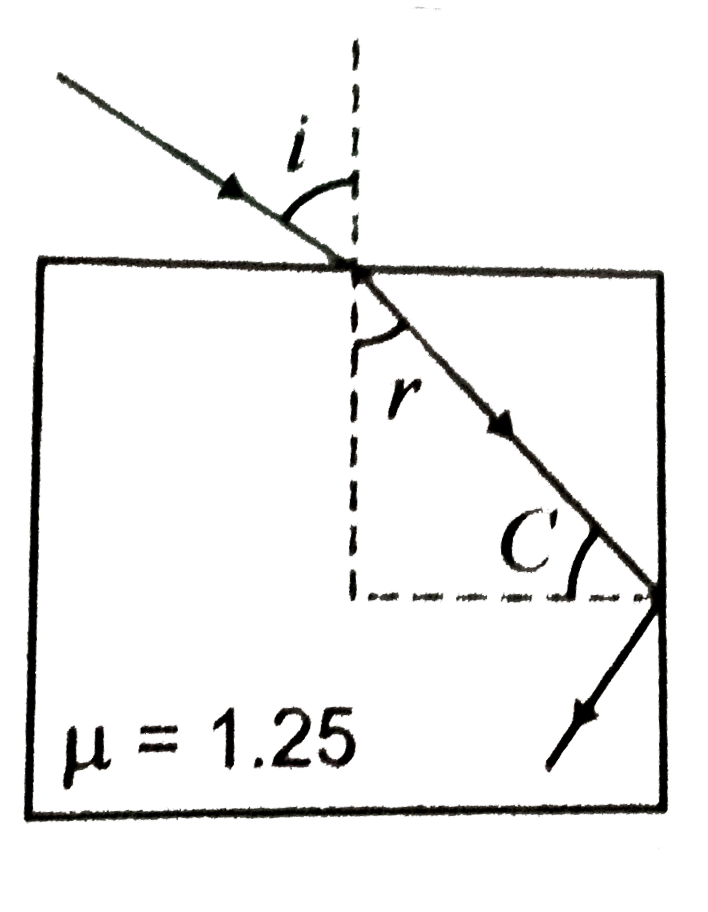Which is true for total internal reflection?
Light travels from rarer to denser medium
Light travels from denser to rarer medium
Independent of the optical densities of two medium
Takes place in the same medium
The correct Answer is:B
Step-by-Step Solution:
1. Understanding the Concept of Total Internal Reflection:
Total internal reflection occurs when light travels from a denser medium to a rarer medium and strikes the interface at an angle greater than the critical angle.
2. Identifying the Mediums:
- Let’s denote the two mediums involved:
- Medium 1 (denser medium) has a refractive index μ2.
- Medium 2 (rarer medium) has a refractive index μ1.
- Here, μ2>μ1.
3. Incident Angle and Critical Angle:
- When light travels from the denser medium (medium 1) to the rarer medium (medium 2), it can be refracted.
- If the angle of incidence i is less than the critical angle C, the light will refract into the rarer medium.
- If the angle of incidence i is equal to the critical angle C, the light will refract along the boundary.
- If the angle of incidence i is greater than the critical angle C, total internal reflection occurs, and the light does not pass into the rarer medium but reflects back into the denser medium.
4. Condition for Total Internal Reflection:
- The condition for total internal reflection is that the light must be moving from a denser medium to a rarer medium, and the angle of incidence must exceed the critical angle.
5. Conclusion:
- Therefore, the statement that is true for total internal reflection is that it occurs when light travels from a denser medium to a rarer medium and the angle of incidence is greater than the critical angle.
Total internal reflection occurs when light travels from a denser medium to a rarer medium and strikes the interface at an angle greater than the critical angle.
- Let’s denote the two mediums involved:
- Medium 1 (denser medium) has a refractive index μ2.
- Medium 2 (rarer medium) has a refractive index μ1.
- Here, μ2>μ1.
- When light travels from the denser medium (medium 1) to the rarer medium (medium 2), it can be refracted.
- If the angle of incidence i is less than the critical angle C, the light will refract into the rarer medium.
- If the angle of incidence i is equal to the critical angle C, the light will refract along the boundary.
- If the angle of incidence i is greater than the critical angle C, total internal reflection occurs, and the light does not pass into the rarer medium but reflects back into the denser medium.
- The condition for total internal reflection is that the light must be moving from a denser medium to a rarer medium, and the angle of incidence must exceed the critical angle.
- Therefore, the statement that is true for total internal reflection is that it occurs when light travels from a denser medium to a rarer medium and the angle of incidence is greater than the critical angle.
Topper's Solved these Questions
- REFRACTION OF LIGHT BOOK - CENGAGE PHYSICSCHAPTER - REFRACTION OF LIGHT EXERCISE - MANDATORY EXERCISE (EXERCISE SET III)
1 Video
- REFRACTION OF LIGHT BOOK - CENGAGE PHYSICSCHAPTER - REFRACTION OF LIGHT EXERCISE - MANDATORY EXERCISE (EXERCISE SET IV)
2 Videos
- REFRACTION OF LIGHT BOOK - CENGAGE PHYSICSCHAPTER - REFRACTION OF LIGHT EXERCISE - MANDATORY EXERCISE (EXERCISE SET I)
21 Videos
- OPTICAL INSTRUMENTS BOOK - CENGAGE PHYSICSCHAPTER - OPTICAL INSTRUMENTS EXERCISE - OLYMPLAD AND NTSE LEVEL EXERCISES
10 Videos
- SOURCES OF ELECTRIC CURRENTBOOK - CENGAGE PHYSICSCHAPTER - SOURCES OF ELECTRIC CURRENTEXERCISE - OLYMPIAD AND NTSE LEVEL EXERCISES
10 Videos
Similar Questions
Knowledge Check
Which of the following is not due to total internal reflection ?
ADifferece between apparent and real depth of a pondBMirage on hot summer daysCBrilliance of diamondDWorking of optical fibreIn the diagram shown, a ray of light is incident on the interface between 1 and 2 at angle slightly greater than critical angle. The light surfers total internal reflection at this interface. After that the light ray falls at the interface of 1 and 3, and again it suffers total internal reflection. Which of the following relations should hold true?
 Aμ1>μ2<μ3Bμ21−μ22>μ23Cμ21−μ23>μ22Dμ21+μ22>μ23
Aμ1>μ2<μ3Bμ21−μ22>μ23Cμ21−μ23>μ22Dμ21+μ22>μ23Consider the ray diagram for the refraction given Fig. The maximum value of angle θ for which the light suffers total internal reflection at the vertical surface, is.
 .Acos−1(34)Bsin−1(34)Ctan−1(43)Dcot−1(43)
.Acos−1(34)Bsin−1(34)Ctan−1(43)Dcot−1(43)
What is total internal reflection of light ? What are conditions for total internal reflection ?
View SolutionWrite the conditions for total internal reflection.
View SolutionConsider the situation shown in figure. Find the maximum angle theta for which the light suffers total internal reflection at the vertical surface.
View SolutionIf two materials have different critical angles with air, which material will have higher chances of total internal reflection?
View SolutionConsider the ray diagram for the refraction given Fig. The maximum value of angle θ for which the light suffers total internal reflection at the vertical surface, is

View Solution


 .
.